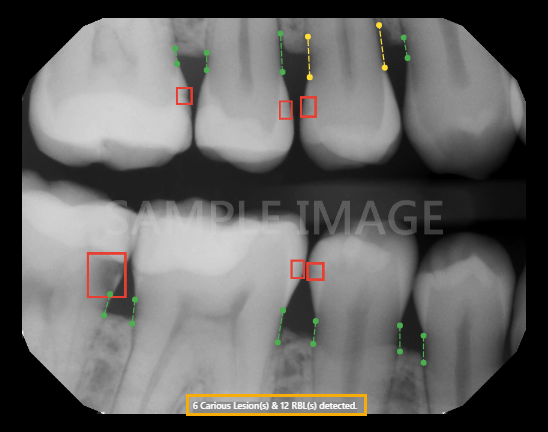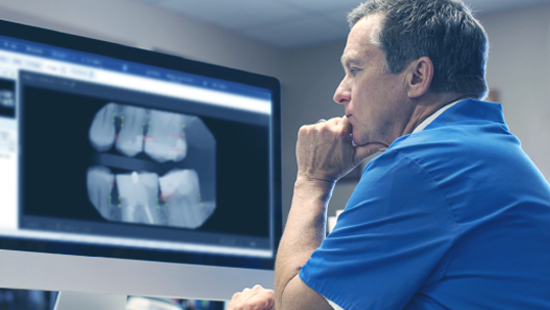Artificial intelligence applications can help you in diagnosing, decision-making, treatment planning, and predicting treatment outcomes. Among these applications, using artificial intelligence as a supplemental tool to support diagnosis is becoming one of the most popular applications in dentistry.
AI in General Dentistry
According to dentists that have used artificial intelligence, AI has been found to help confirm carious lesions that might have gone missed and gotten worse for their patients.[1] In general dentistry, dentists diagnose caries using a combination of visual and tactile examination and radiographic examination. As a supplemental tool, artificial intelligence can help dentists detect early-stage lesions and the occasional missed carious lesion. Often early-stage interproximal carious lesions can be difficult to diagnose especially when overcrowding and tight interproximal contacts are present. Eventually, these lesions get noticed when they are in later stages, which leads to restorative treatments such as a crown, root canal therapy, or even an implant to restore the tooth.[2] When comparing the cost-effectiveness of AI for proximal caries detection versus diagnosis methods without AI, studies have concluded that AI was more effective and less costly.[3]
AI in Periodontics
In periodontics, hygienists and dentists use artificial intelligence to help them more effectively identify signs of periodontal disease. According to the CDC, “47.2% of adults aged 30 years and older have some form of periodontal disease. Periodontal disease increases with age, 70.1% of adults 65 years and older have periodontal disease.”[4] If left untreated, periodontitis can lead to tooth mobility and even tooth loss. To prevent severe periodontitis, early detection and treatment are needed. Dental practitioners have found that artificial intelligence not only empowers them to make better treatment recommendations but also provides intuitive visualizations that make it very easy for them to educate patients and explain findings to them.[5]
Over the last couple of decades, new technologies have been developed and adopted in the dental field. Artificial intelligence is among the most promising technologies because it is known for its high accuracy and efficiency.[6] Dental practitioners can use AI as a supplemental tool to reduce their workload and improve precision and accuracy in diagnosis, decision-making, and treatment planning. Additionally, dentists and hygienists that are using artificial intelligence agree that they have easier treatment acceptance and more confident diagnoses.[7]
AI In Dentrix Ascend
Dentrix Ascend Detect AI is an X-ray analysis software that uses artificial intelligence (AI) to detect carious lesions and measure interproximal bone levels for clinical accuracy. This technology has FDA clearance and is conveniently built right into Dentrix Ascend Imaging so that it fits seamlessly into your imaging workflow and helps you provide the highest level of care for your patients.

Additional Information
- Dentrix Ascend Detect AI is an additional service to your Dentrix Ascend subscription.
- To learn more about Dentrix Ascend Detect AI, watch Dentrix Ascend Detect AI Overview.
- For more information about Dentrix Ascend Detect AI or to see a free demo, visit the Dentrix Ascend Detect AI product page.
- Read Dentrix Ascend Detect AI to learn more about how Dentrix Ascend Detect AI helps your practice profitability.
[1] Videa Health (2023) Customer Stories https://www.videa.ai/customer-stories
[2] Ding H, Wu J, Zhao W, Matinlinna JP, Burrow MF and Tsoi JKH (2023) Artificial intelligence in dentistry—A review. Front. Dent. Med 4:1085251. https://doi.org/10.3389/fdmed.2023.1085251
[3] Schwendicke, F., Rossi, J. G., Göstemeyer, G., Elhennawy, K., Cantu, A. G., Gaudin, R., Chaurasia, A., Gehrung, S., & Krois, J. (2021). Cost-effectiveness of Artificial Intelligence for Proximal Caries Detection. Journal of dental research, 100(4), 369–376. https://doi.org/10.1177/0022034520972335
[4] Centers for Disease Control and Prevention (2023) Periodontal Disease https://www.cdc.gov/oralhealth/conditions/periodontal-disease.html#:~:text=A%20recent%20CDC%20report1,and%20older%20have%20periodontal%20disease.
[5] Videa Health (2023) Customer Stories https://www.videa.ai/customer-stories
[6] Ding H, Wu J, Zhao W, Matinlinna JP, Burrow MF and Tsoi JKH (2023) Artificial intelligence in dentistry—A review. Front. Dent. Med 4:1085251. https://doi.org/10.3389/fdmed.2023.1085251
[7] Videa Health (2023) Customer Stories https://www.videa.ai/customer-stories

